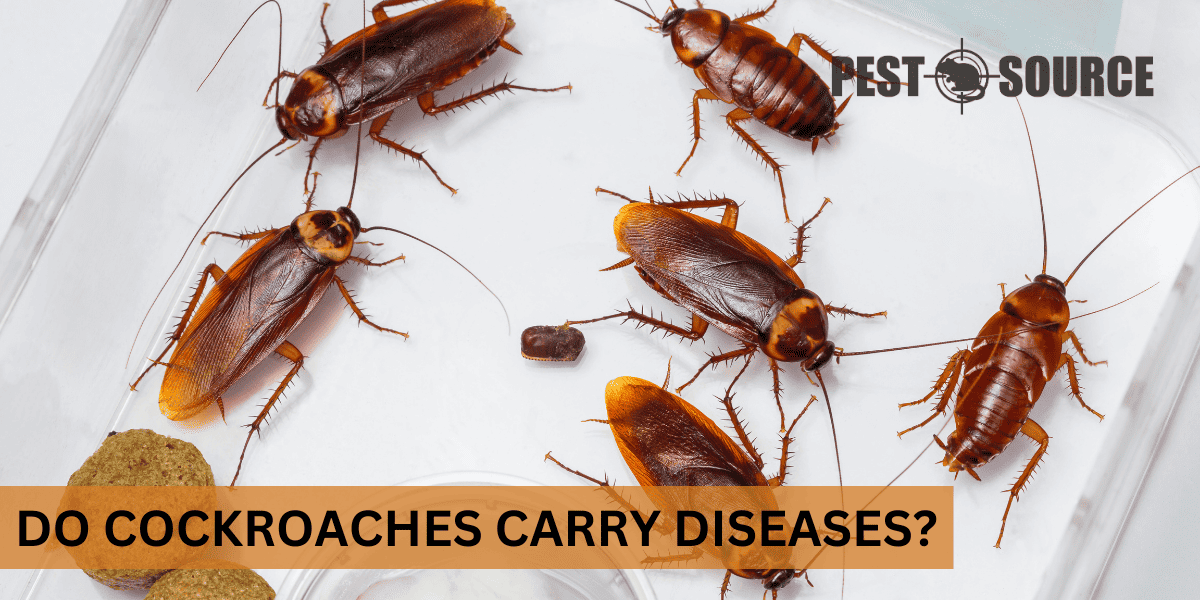Cockroaches can carry and spread various pathogens, potentially causing diseases in humans. This article discusses the health risks associated with cockroaches and the importance of effective pest control.
POINTS
- Cockroaches can carry and spread a variety of diseases, including Salmonella, E. coli, and allergens that exacerbate asthma and allergies, through their droppings, saliva, and decaying bodies.
- Health risks from cockroach infestations include bacterial infections and allergic reactions, with symptoms such as stomach cramps, fever, diarrhea, and vomiting indicating potential illnesses from cockroach-borne pathogens.
- Different cockroach species, such as the German and American cockroaches, have varying capacities to spread diseases, with the German cockroach noted for its rapid reproduction and ability to spread diseases more effectively in homes.
- Common myths about cockroaches include the belief that they only infest dirty homes and that they spread diseases through bites, whereas the primary concern is contamination of food and surfaces.
- Preventive measures to reduce the risk of cockroach infestations and disease transmission include maintaining cleanliness, proper food storage, sealing entry points, managing waste, reducing moisture, and seeking professional pest control services.
What Disease Does Roaches Carry?
Cockroaches are more than just unwelcome guests in our homes; they pose significant health risks due to their potential to carry a range of diseases. These resilient pests are known to scavenge in unsanitary areas such as sewers and garbage bins, which can contaminate their bodies with various pathogens. They can then transport these pathogens into our living spaces.
Diseases potentially spread by cockroaches include bacterial infections, parasitic worms, and certain viruses. The concern for health is not unfounded, given that cockroaches have been implicated in the spread of illness in various environments.
Specific Diseases Transmitted by Cockroaches and Their Transmission Methods
Cockroaches are known carriers of numerous diseases, with some of the most common being Salmonella typhi, which causes typhoid fever; various Escherichia coli (E. coli) strains; and Enterococcus faecalis, which can lead to urinary tract infections and other conditions. They also can spread certain allergens that contribute to asthma and allergies.
The transmission of these diseases occurs through several mechanisms. Cockroaches can spread disease-causing organisms through their droppings, saliva, and the decaying bodies of dead roaches. They pick up pathogens on their leg spines and bodies while crawling through contaminated environments and then deposit these pathogens on food surfaces and utensils as they move through our homes. This contamination can lead to the ingestion of harmful bacteria and viruses, resulting in illness.
Health Risks and Symptoms Associated with Cockroach Infestations
The health risks associated with cockroach infestations are not to be taken lightly. These pests can be carriers of bacteria that lead to food poisoning, diarrhea, and other gastrointestinal issues. Moreover, the allergens found in cockroach droppings and shed skins can exacerbate asthma symptoms, particularly in children.
Symptoms that might indicate illnesses caused by cockroach-borne pathogens include stomach cramps, fever, diarrhea, and vomiting. If you experience these symptoms and suspect a cockroach infestation in your home, it is crucial to seek medical attention promptly. Professional pest control combined with medical treatment can mitigate the risks and address the underlying infestation.
Variability in Disease Transmission Among Different Cockroach Species
Different species of cockroaches may vary in their capacity to spread diseases. The German cockroach (Blattella germanica) and the American cockroach (Periplaneta americana) are two of the most common species that infest human dwellings. The German cockroach is particularly notorious for its rapid reproduction rate and its ability to spread diseases within homes. They are smaller, which allows them to hide more easily in various environments. The American cockroach, being larger, tends to inhabit warmer and more humid areas, such as basements and sewers, and can also carry disease-causing pathogens into homes.
Understanding the habits and preferences of different cockroach species is crucial for effective pest control and preventing the spread of diseases.
Myths, Misconceptions, and Preventive Measures
When it comes to cockroaches and the diseases they carry, there are several myths and misconceptions that can lead to misunderstandings about the risks and how to manage them. One common myth is that cockroaches only infest dirty homes. While cleanliness can deter infestations, even clean homes can become infested due to the cockroaches’ ability to enter through tiny cracks and thrive on minimal resources.
Another misconception is that cockroaches bite humans and spread diseases through bites. While cockroaches can bite, this is extremely rare and not a significant mode of disease transmission. The primary concern is their contamination of food and surfaces through feces and other secretions.
To prevent cockroach infestations and reduce the risk of disease transmission, consider the following practical advice:
- Maintain Cleanliness: Regularly clean your home, including sweeping floors and wiping down surfaces to remove food particles and spills.
- Proper Food Storage: Store food in sealed containers and avoid leaving pet food out overnight.
- Seal Entry Points: Inspect your home for cracks and crevices, especially in kitchens and bathrooms, and seal them with caulk or other appropriate materials.
- Manage Waste: Dispose of garbage promptly in sealed containers and keep compost bins at a distance from your home.
- Reduce Moisture: Fix leaky pipes and faucets, as cockroaches are attracted to moisture.
- Professional Pest Control: If you suspect an infestation, consult a professional pest control service to apply safe and effective treatments.
By implementing these measures, you can significantly lower the chances of a cockroach infestation and the associated health risks.
Recent Research and Findings
Recent scientific research continues to shed light on the relationship between cockroaches and the spread of diseases. Studies have focused on the microbial communities found in cockroach guts, revealing a diverse array of bacteria, some of which are pathogenic to humans. Other research has explored the role of cockroach allergens and their impact on respiratory health, particularly in urban environments where cockroach populations are high.
Emerging findings suggest that understanding the genetic makeup of cockroaches could lead to more targeted pest control methods that are both effective and environmentally friendly. Additionally, ongoing research into the microbial load carried by cockroaches may provide insights into preventing the spread of antibiotic-resistant bacteria.
Staying informed about these developments is crucial for pest control professionals and homeowners alike, as new insights can lead to improved strategies for managing cockroach populations and minimizing health risks. By combining current scientific knowledge with practical prevention techniques, we can better safeguard our homes and health from the threats posed by these persistent pests.
Are Cockroaches Dangerous?
Cockroaches are dangerous and pose many health risks. Their potential to carry diseases is significant due to their habit of scavenging in unhygienic areas. They can spread bacteria such as E. coli and Salmonella by contaminating food surfaces and supplies. Although they are not directly aggressive towards humans, their presence and waste can lead to health concerns. Thus, while cockroaches may not be dangerous in the sense of direct physical harm, their indirect impact on health and hygiene is substantial.



